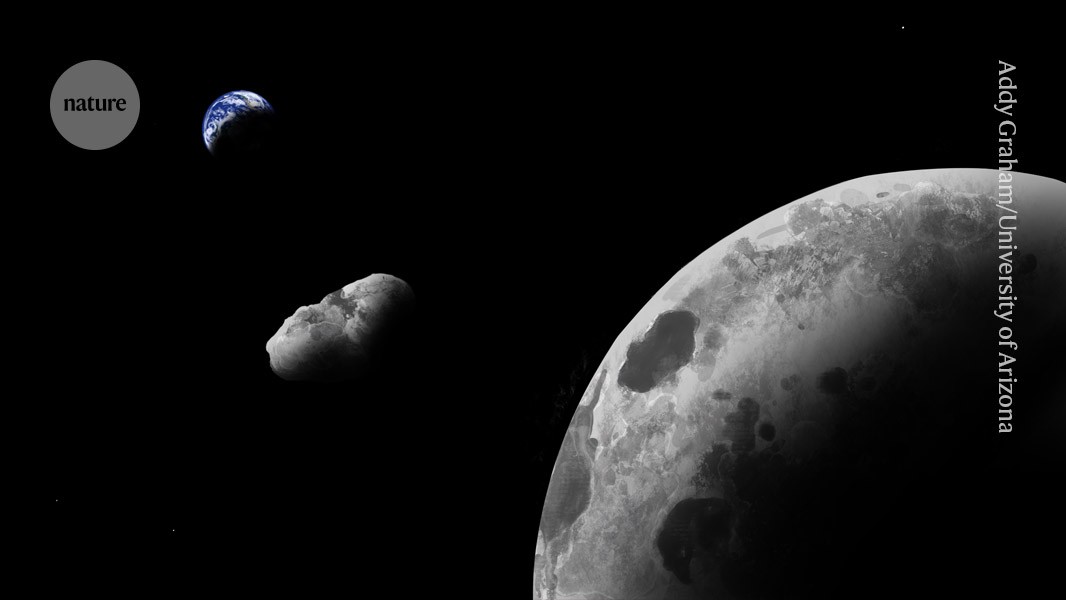First Chinese mission to sample an asteroid starts its journey

Over a decade, Tianwen-2 will sample rocks from a near-Earth asteroid, return them to Earth and then visit a comet

The quasi-satellite Kamo‘oalewa (centre, artist’s impression) dances around Earth but isn’t tied to the planet by its gravity.Credit: Addy Graham/University of Arizona
China has sent a probe on an ambitious mission to grab rocks from a near-Earth asteroid and return them to Earth before making a final visit to a distant comet.
Tianwen-2 blasted off from Xichang launch centre in southern China at 1:31AM Beijing time today.
“Watching it tear through the sky, in that moment, my heart truly swelled with emotion ,” says Su Yan, chief designer of the mission’s data collection system at the National Astronomical Observatories of the Chinese Academy of Sciences (NAOC) in Beijing, who witnessed the launch from Xichang.
“I was thrilled to hear about the successful launch,” adds Mikael Granvik, a planetary scientist at Luleå University of Technology in Kiruna, Sweden.
The spacecraft is now on its way to Kamo‘oalewa, an asteroid between 40 and 100 metres wide. The asteroid’s small size and fast spin — a full rotation takes only 28 minutes — will make gathering samples challenging.
Other countries have brought back samples from asteroids. Japan nipped bits off asteroids Itokawa and Ryugu, and the United States snatched samples from Bennu. China has previously returned samples from the Moon’s near and far sides.
Kamo‘oalewa is considered a quasi-satellite of Earth: it dances around the planet in an oscillating orbit, but is too far away to be tied to Earth by gravity, as the Moon is. The asteroid basically hangs around Earth’s vicinity, says Li Chunlai, a planetary scientist at the NAOC in Beijing.
By studying samples from Kamo‘oalewa, researchers hope to determine whether it was once part of the Moon — and was chipped away during a collision event — or has escaped from the asteroid belt that circles between Mars and Jupiter. “This is still debatable,” says Marco Fenucci, a mathematician who studies the dynamics of small astronomical bodies at the European Space Agency, near Rome. No asteroids in the Solar System are known to come from the Moon. “I am really excited for what is to come and to see what surprises this asteroid will reveal,” says Fenucci, following news of the successful launch. Fenucci expects researchers will learn a lot about asteroids of Kamo‘oalewa’s size from the mission.
The samples will also help researchers to understand how asteroids form and evolve, says Li.
Three options
As Tianwen-2 heads towards Kamo‘oalewa, it will make a few tweaks to its course, open up its solar-panel wings and test its scientific instruments. It is scheduled to arrive at its first stop in the middle of next year, and stay there for about nine months, according to posts on social media.
The Tianwen-2 team doesn’t quite know what to expect when the craft arrives at Kamo‘oalewa, so has planned three approaches for collecting samples. The first strategy involves the probe descending to about one metre above the asteroid, and hovering while a robotic arm extends to collect material from the surface. The spacecraft could also extend a sampling probe that brushes up loose material. And if conditions permit, the spacecraft will land on the asteroid with its three legs and anchor itself with the robotic arm to collect material.
Enjoying our latest content?
Login or create an account to continue
- Access the most recent journalism from Nature's award-winning team
- Explore the latest features & opinion covering groundbreaking research
or
Sign in or create an accountdoi: https://doi.org/10.1038/d41586-025-01672-1
This story has been updated to include comments following the launch.
This story originally appeared on: Nature - Author:Smriti Mallapaty

















